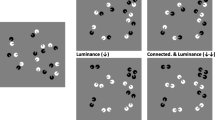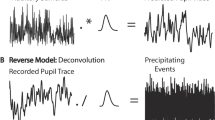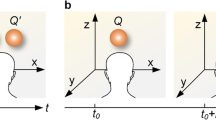Abstract—
The influence of additional visual information on the process of maintaining a vertical posture on a compliant support was studied. The subjects stood in stereo glasses and a mask that limited the field of view in a darkened room in front of a screen on which a three-dimensional image of a dark gray sphere was projected. The virtual sphere covered a field of view of approximately 36°. The presentation of the sphere was combined with the introduction of additional fixed objects (dots with an area of 1 cm2). The latter, in the amount of one or four, could be present in different places, but within the area covered by the sphere. In the control trials, the sphere was motionless. In test trials, the position of the sphere depended on body oscillations in the anteroposterior and lateral directions in such a way that body shifts caused the sphere to move in the same (in-phase connection, IP) or opposite directions (antiphase connection, AP). The contribution of visual control to posture maintenance was assessed by changes in the amplitude—frequency characteristics of elementary variables calculated from the trajectory of the sole center of pressure (CP). These variables were the vertical projection of the body’s center of gravity (CG) and the difference between the CP and the vertical projection of the center of gravity (CP–CG). An analysis of the CG and CP–CG variables revealed a clear dependence of their spectra on the direction of the connection between the shifts of the body and the sphere, as well as the influence of the presence of fixed points on this dependence. Thus, in test trials, in standing position with open eyes and in the absence of additional fixed points, the oscillations in the sagittal plane increased significantly compared to the control. In particular, there was an approximately 2.5-fold increase in the root-mean-square value of the amplitude spectra (RMS) under IP conditions and a 2-fold increase under AP conditions, while the RMS values of the spectra were also significantly higher than when standing with closed eyes. When one fixed point was added in the center of the screen as a fixed reference point, the oscillations practically did not change. When four points symmetrically located at a distance of 8.75 cm from the center of the screen were added, the RMS spectra of both variables decreased by 20–25%. With an increase in the distance between the points up to 35 cm, a further 30–35% decrease in body oscillations was observed. At a distance of 70 cm between the points (equal to the sphere diameter), the RMS of the spectra decreased by 45–50%. Under these conditions, the magnitude of body oscillations became approximately the same as with closed eyes. Thus, it is shown that under conditions of instability of the visual environment, the presence of stationary objects of small size significantly affects posture maintenance, but the quality of standing still remains lower than in a stationary visual environment.




Similar content being viewed by others
REFERENCES
Perennou, D., Mazibrada, G., Chauvineau, V., et al. Lateropulsion, pushing and verticality perception in hemisphere stroke: a causal relationship? Brain, 2008, vol. 131, p. 2401.
Barra, J., Oujamaa, L., Chauvineau, V., et al., Asymmetric standing posture after stroke is related to a biased egocentric coordinate system, Neurology, 2009, vol. 72, no. 18, p. 1582.
Bonan, I.V., Hubeaux, K., Gellez-Leman, M.C., et al., Influence of subjective visual vertical misperception on balance recovery after stroke, J. Neurol. Neurosurg. Psychiatry, 2007, vol. 78, no. 1, p. 49.
Keisuke, T., Sho, I., Shinji, Y., et al., Effect of dynamic visual motion on perception of postural vertical through the modulation of prior knowledge of gravity, Neurosci. Lett., 2020, vol. 716, p. 134687.
Balestrucci, P., Daprati, E., Lacquaniti, F., and Maffei, V., Effects of visual motion consistent or inconsistent with gravity on postural sway, Exp. Brain Res., 2017, vol. 235, no. 7, p. 1999.
Angelaki, D.E., Gu, Y., and DeAngelis, G.C., Multisensory integration: psychophysics, neurophysiology, and computation, Curr. Opin. Neurobiol., 2009, vol. 19, no. 4, p. 452.
Trousselard, M., Cian, C., Nougier, V., et al. Contribution of somesthetic cues to the perception of body orientation and subjective visual vertical, Percept. Psychophys., 2003, vol. 65, no. 8, p. 1179.
Carriot, J., Barraud, P.A., and Nougier, V., and Cian, C., Difference in the perception of the horizon during true and simulated tilt in the absence of semicircular canal cues, Exp. Brain Res., 2006, vol. 174, no. 1, p. 158.
Carriot, J., Dizio, P., and Nougier, V., Vertical frames of reference and control of body orientation, Neurophysiol. Clin., 2008, vol. 38, no. 6, p. 423.
Cian, C., Esquivie, D., Barraud, P.A., and Raphel, C., Respective contribution of orientation contrast and illusion of self-tilt to the rod-and-frame effect, Perception., 1995, vol. 24, no. 6, p. 623.
Dichgans, J., Held, R., Young, L.R., and Brandt, T., Moving visual scenes influence the apparent direction of gravity, Science, 1972, vol. 178, no. 4066, p. 1217.
Roberts, R.E., Da Silva Melo, M., Siddiqui, A.A., et al., Vestibular and oculomotor influences on visual dependency, J. Neurophysiol., 2016, vol. 116, no. 3, p. 1480.
De Vrijer, M., Medendorp, W.P., and Van Gisbergen, J.A., Shared computational mechanism for tilt compensation accounts for biased verticality percepts in motion and pattern vision, J. Neurophysiol., 2008, vol. 99, no. 2, p. 915.
Tarnutzer, A.A., Bockisch, C., Straumann, D., and Olasagasti, I., Gravity dependence of subjective visual vertical variability, J. Neurophysiol., 2009, vol. 102, no. 3, p. 1657.
Schuler, J.R., Bockisch, C.J., Straumann, D., and Tarnutzer, A.A., Precision and accuracy of the subjective haptic vertical in the roll plane, BMC Neurosci., 2010, vol. 11, p. 83.
Wade, S.W. and Curthoys, I.S., The effect of ocular torsional position on perception of the roll-tilt of visual stimuli, Neurosci. Lett., 2020, vol. 716, p. 134687.
Kozhina, G.V., Levik, Yu.S., Popov, A.K., et al., Visuomotor adaptation in healthy humans in standing position under the conditions of destabilization of virtual visual environment, Hum. Physiol., 2018, vol 44, no. 5, p. 517. https://doi.org/10.1134/S0362119718050055
Smetanin, B.N., Levik, Yu.S., Kozhina, G.V., and Popov, A.K., The influence of the size of the object, providing the visual feedback on the maintenance of the vertical posture in humans, Hum. Physiol., 2020, vol. 46, no. 6, p. 677.
Burdea, G. and Coiffet, P., Virtual Reality Technology, New York: Wiley, 2003.
Benjuya, N., Melzer, I., and Kaplanski, J., Aging-induced shifts from a reliance on sensory input to muscle cocontraction during balanced standing, J. Gerontol., Ser. A, 2004, vol. 59, no. 2, p. 166.
Wiesmeier, I.K., Dalin, D., and Maurer, C., Elderly use proprioception rather than visual and vestibular cues for postural motor control, Front. Aging Neurosci., 2015, vol. 7, p. 97.
Vieiran, T. M., de Oliveiran, L.F., and Nadal, J., An overview of age-related changes in postural control during quiet standing tasks using classical and modern stabilometric descriptors, J. Electromyogr. Kinesiol., 2009, vol. 19, no. 6, p. 513.
Seigle, B., Ramdani, S., and Bernard, P.L., Dynamical structure of center of pressure fluctuations in elderly people, Gait Posture, 2009, vol. 30, no. 2, p. 223.
Prieto, T.E., Myklebust, J.B., Hoffmann, R.G., et al., Measures of postural steadiness: differences between healthy young and elderly adults, IEEE Trans. Biomed. Eng., 1996, vol. 43, no. 9, p. 956.
Fino, P.C., Mojdehi, A.R., Adjerid, K., et al., Comparing postural stability entropy analyses to differentiate fallers and non-fallers, Ann. Biomed. Eng., 2016, vol. 44, no. 5, p. 1636.
Danna-Dos-Santos, A., Degani, A.M., Boonstra, T.W., et al., The influence of visual information on multi-muscle control during quiet stance: a spectral analysis approach, Exp. Brain Res., 2015, vol. 233, no. 2, p. 657.
Oie, K.S., Kiemel, T., and Jeka, J.J., Multisensory fusion: simultaneous re-weighting of vision and touch for the control of human posture, Brain Res. Cogn. Brain Res., 2002, vol. 14, no. 1, p. 164.
Polastri, P.F. and Barela, J.A., Adaptive visual re-weighting in children’s postural control, PLoS One, 2013, vol. 8, no. 12. e82215
Mahboobin, A., Loughlin, P.J., Redfern, M.S., and Sparto, P.J., Sensory re-weighting in human postural control during moving-scene perturbations, Exp. Brain Res., 2005, vol. 167, no. 2, p. 260.
Borger, L.L., Whitney, S.L., Redfern, M.S., and Furman, J.M., The influence of dynamic visual environments on postural sway in the elderly, J. Vestib. Res., 1999, vol. 9, no. 3, p. 197.
Funding
This study was carried out within the State Task of the Ministry of Science and Higher Education of the Russian Federation, project no. 0061-2019-0012.
Author information
Authors and Affiliations
Corresponding author
Ethics declarations
All procedures performed in studies involving human participants were in accordance with the biomedical ethics principles formulated in the 1964 Helsinki Declaration and its later amendments and approved by the local Bioethics Committee of the Kharkevich Institute for Information Transmission Problems, Russian Academy of Sciences (Moscow).
Conflict of interest. The authors declare that they do not have a conflict of interest.
Informed consent. Each study participant provided a voluntary written informed consent signed by him after explaining to him the potential risks and benefits, as well as the nature of the upcoming study.
Additional information
Translated by E. Babchenko
Rights and permissions
About this article
Cite this article
Kozhina, G.V., Levik, Y.S., Popov, A.K. et al. Influence of Fixed Point Marks on Maintaining a Vertical Posture when Observing a Virtual Three-Dimensional Object Linked to Body Oscillations. Hum Physiol 48, 687–695 (2022). https://doi.org/10.1134/S0362119722700128
Received:
Revised:
Accepted:
Published:
Issue Date:
DOI: https://doi.org/10.1134/S0362119722700128




